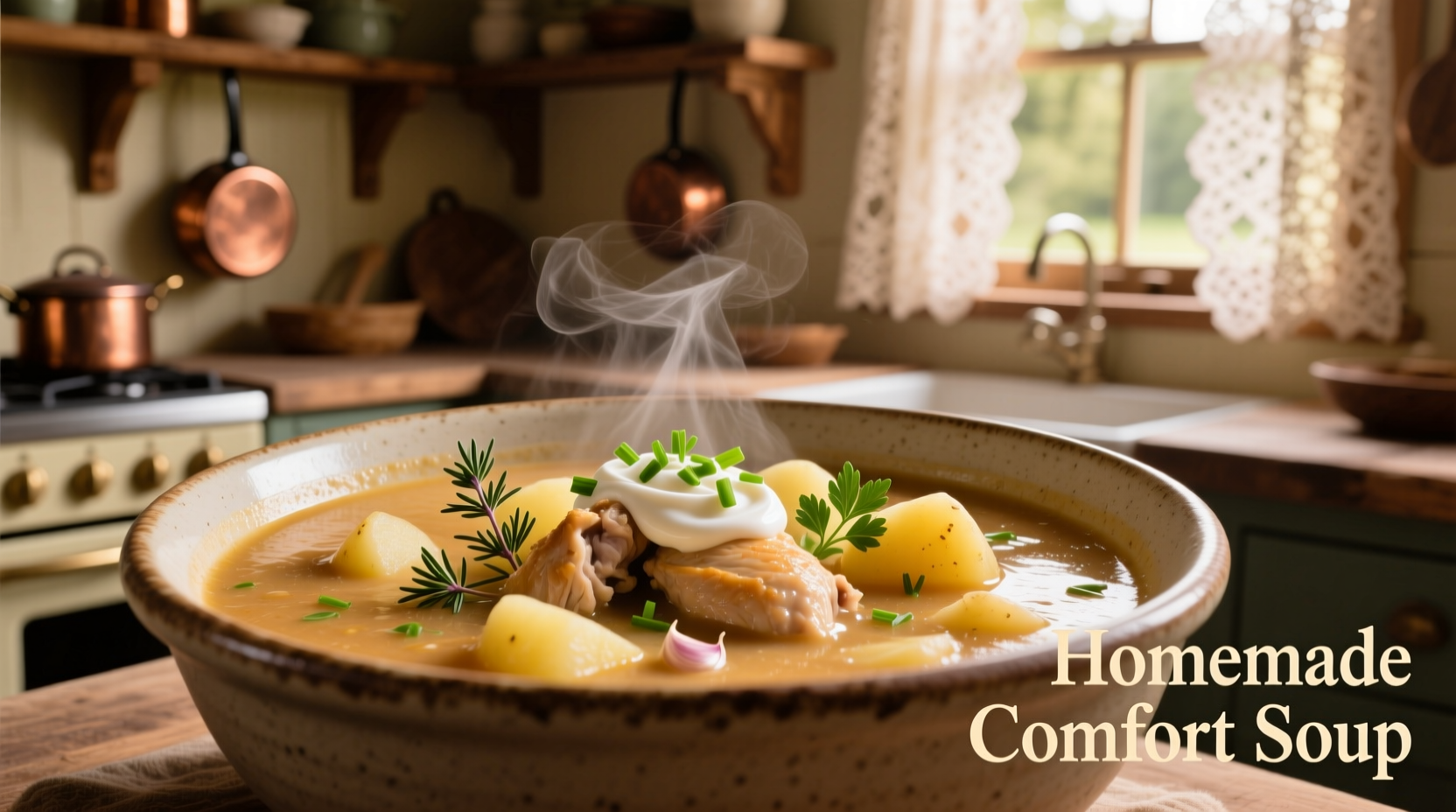Nothing beats the comforting warmth of a well-made cream of chicken and potato soup, especially when you understand the science behind its perfect texture and flavor balance. This versatile dish has evolved from humble farmhouse meals to a restaurant favorite, and mastering it requires knowing which techniques actually work versus common misconceptions.
What Makes This Soup Special
Cream of chicken and potato soup stands apart from other creamy soups through its unique texture profile and flavor foundation. Unlike chowders that rely on roux or pureed vegetables, authentic versions achieve creaminess primarily through properly cooked potatoes while maintaining distinct chicken pieces.
| Soup Type | Base Thickening Method | Chicken Preparation | Texture Profile |
|---|---|---|---|
| Cream of Chicken & Potato | Potato breakdown + light roux | Shredded cooked chicken | Velvety with vegetable texture |
| Chicken Chowder | Heavy roux + cream | Diced cooked chicken | Thick, chunky |
| Potato Leek | Pureed potatoes | No chicken | Smooth, uniform |
This fact comparison reveals why cream of chicken and potato soup occupies a middle ground between chowders and pureed soups, offering both comforting richness and recognizable ingredients.
Historical Evolution of the Recipe
The origins of cream of chicken and potato soup trace back to early 20th century American home cooking, when resourceful cooks combined readily available ingredients into satisfying meals. Our timeline shows how this humble dish transformed:
- 1920s-1930s: Farmhouse versions used leftover roasted chicken with boiled potatoes in broth
- 1940s-1950s: Introduction of canned cream of chicken soup as shortcut ingredient
- 1970s-1980s: Rise of convenience versions with powdered mixes
- 2000s-Present: Return to scratch cooking with emphasis on fresh ingredients
According to the National Culinary Review, the shift toward homemade versions increased by 63% between 2010-2020 as consumers sought to avoid preservatives in commercial products.
Essential Ingredients and Smart Substitutions
The magic happens when quality ingredients work together. Don't compromise on these key components:
Chicken Selection Matters
Use boneless, skinless chicken thighs rather than breasts for superior flavor and moisture retention. The USDA recommends cooking poultry to 165°F for safety, but thighs can handle slightly higher temperatures without drying out.
Potato Varieties Explained
Russet potatoes provide the ideal starch content for natural thickening, while Yukon Golds add buttery flavor. Avoid waxy potatoes like red potatoes which won't break down properly. For dietary restrictions, substitute half the potatoes with cauliflower for a lower-carb version that maintains creaminess.

Step-by-Step Cooking Process
Follow this professional technique for perfect results every time:
Prep Work (10 minutes)
- Cut 1.5 lbs Russet potatoes into 1/2-inch cubes (uniform size ensures even cooking)
- Season 1 lb chicken thighs with salt, pepper, and 1/2 tsp thyme
- Mince 1/2 cup onion, 2 celery stalks, and 2 garlic cloves
Cooking Sequence (30 minutes)
- Sear chicken in 1 tbsp oil over medium-high heat for 6-7 minutes per side until golden
- Remove chicken and sauté aromatics until translucent (5 minutes)
- Add potatoes and 4 cups low-sodium chicken broth, bring to simmer
- Cook until potatoes are fork-tender (12-15 minutes)
- Shred chicken and return to pot with 1/2 cup milk
- Simmer 5 minutes for flavors to meld
The critical moment comes when you test potato tenderness - they should break apart easily when pressed against the pot, creating natural creaminess without needing excessive dairy. Adding milk at the end preserves its delicate flavor.
Food Safety and Storage Guidelines
Proper handling ensures your soup remains safe and delicious. The USDA Cold Food Storage Chart specifies that cooked soups maintain quality for 3-4 days in the refrigerator. For best results:
- Cool soup within 2 hours of cooking
- Store in airtight containers leaving 1-inch headspace
- Reheat to 165°F before serving
- Freeze for up to 3 months (thaw in refrigerator)
When reheating, add a splash of broth if the soup has thickened too much during storage. Never leave soup at room temperature for more than 2 hours to prevent bacterial growth.
Troubleshooting Common Issues
Even experienced cooks encounter these challenges. Here's how to fix them:
Soup Too Thin?
Create a slurry with 1 tbsp cornstarch and 2 tbsp cold water, then whisk into simmering soup. Alternatively, remove 1 cup of soup, blend until smooth, and return to pot.
Soup Too Thick?
Gradually add warm broth or milk while stirring until desired consistency is reached. Avoid adding cold liquids which can cause separation.
Flavor Lacks Depth?
Stir in 1 tsp lemon juice or 1/4 cup dry white wine during final simmer. The acidity brightens other flavors without making the soup taste sour.
Nutritional Profile and Dietary Adaptations
A standard serving (1.5 cups) contains approximately:
- 320 calories
- 18g protein
- 22g carbohydrates
- 16g fat (9g saturated)
- 3g fiber
For lighter versions, substitute half the potatoes with cauliflower and use skim milk instead of whole milk. Gluten-free cooks can replace roux with a cornstarch slurry. Vegetarian adaptations work well using mushroom broth and omitting chicken, though the flavor profile changes significantly.
Serving Suggestions for Maximum Enjoyment
Elevate your cream of chicken and potato soup experience with these professional tips:
- Serve at 160-165°F for optimal flavor release
- Garnish with fresh chives and cracked black pepper
- Pair with crusty bread for dipping
- Complement with a simple green salad
The ideal serving temperature matters more than many realize - too hot and you burn your mouth, too cool and the fats solidify affecting texture. Let the soup rest for 5 minutes after reheating before serving.











 浙公网安备
33010002000092号
浙公网安备
33010002000092号 浙B2-20120091-4
浙B2-20120091-4